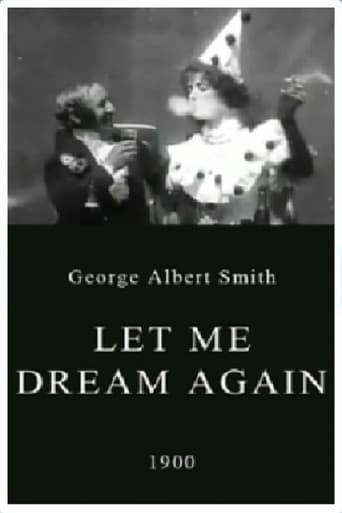Horst in Translation (filmreviews@web.de)
I have to say that even with the spoiler in the title I did not see the final plot twist coming and had to laugh quite a bit. Also the actors' face expressions were really spot-on. Early on we see a man and a woman having a great time, drinking, smoking and joking around. Such a fun scene really. But could it all be true? Bummer. The director is George Albert Smith here, one of Britains very early and very prolific filmmakers. The lead actress played in a couple more films and so did the lead actor who was also a fairly prolific filmmaker himself. I thought this started off a bit slowly, but got better quickly and was actually really good at the end. Certainly worth a watch. A contender for best film and best comedy movie of 1900 in my opinion.
Cineanalyst
Dreams are closely associative with cinema. That idea isn't really explored here, as the film only consists of two scenes and lasts around a minute. However, it is an early exploration of the film language of how to tell a dream and how to tell, or separate, the inner narrative of the dream from the outer narrative of "reality". Moreover, it's a rather early film to consist of spatially separate scenes, although there had been a few already, including G.A. Smith's own "The Kiss in the Tunnel" (1899).The first scene is the dream and the film narrated by the male character within the dream. He's fantasizing about having an affair with a younger woman. In the second scene, we see him awake in bed with his older, less attractive "real" wife. Smith's transition between shots consists of an in-camera out-of-focusing at the end of the first shot and then beginning the second scene out-of-focus before pulling it within focus. There's also a sort of disrupted match on action, with the actors being within the same position for each scene--the man continuing his embracing action into the second shot. It's a good effect, especially for its continuity and how the focusing is analogous to coming out of a dream and awakening. Ferdinand Zecca, for Pathé, used a dissolve in his remake, "Dream and Reality" (Rêve et réalité) (1901), but, then, he seems to have been using dissolves for all shot transitions at this time.Many of the other early films about dreams don't split the scenes, but the separation of dream world and "reality" is implied by the character going to sleep, weird things happening, and then the actor waking up. These are usually trick shot films, which Georges Méliès largely invented. Edwin Porter's "Dream of a Rarebit Fiend" (1906) is an example. Another way to separate them was with a scene-within-a-scene, accomplished by blacking out part of the set, or masking part of the camera lens, and filming the awake part; then, the effect is reversed and filmed again. Zecca did this in "Story of a Crime" (Historie d'un crime) (1901), and Porter did it in "Life of an American Fireman" (1903) and other films. Smith actually introduced this scene-within-a-scene effect to motion pictures with such films as "Santa Claus" (1898). These early efforts aren't quite as interesting and exciting as, say, "Sherlock, Jr." (1924) or "Eternal Sunshine of the Spotless Mind" (2004), but they are important for having gotten us started.
Snow Leopard
With an idea that was creative for its time, and a theme that still retains some interest, "Let Me Dream Again" is still worth seeing despite its unpolished look. It was one of the very earliest attempts to film a story that compared dream and reality, and while there are later imitations of the story with a more refined technique, this is the one that should probably get the credit for the basic idea.The comparison between the man's dream and the reality of his life certainly makes a comic point, but at the same time, it suggests some more general ideas about what people want their lives to be. The man in the story does not come across as an interesting person in himself, and the story itself is quite rudimentary - yet in watching the main character, you're not quite sure whether to respond with pity, scorn, laughter, or some of all three.While very simple, these very old, very short features often handle these kinds of themes in an economical fashion that contrasts well with the excessive approach that has become all too common in the 21st century.
Alice Liddel
Another familiar trope that will seem poignant to many people. A man is wining and dining a young lady only to wake up beside an old shrew who gives him what for. The master of this dream/reality narrative is Buster Keaton, who developed it with heartbreaking inventiveness.This film is not without interest though. Firstly, the dream sequence is excellently imagined, with the couple dining in the foreground and a blank background creating a suitably unreal effect. The symmetry between couples is effective, suggesting that the wife may once have been like this one, asking us to ponder the processes that led to her 'decline', even the possibility of the husband's malign influence. Of course, this symmetry is actually a representation of rupture, division, disharmony - between dream and reality, the ideal and the mundane, the young and the old, the unattainable and the attainable.The strange thing about the dream is that, firstly, the woman is unattainable in it, she flirts, but she doesn't give herself; secondly, she is dressed in a costume reminiscent of the circus or carnival. Here the dream is something subversive, something that can critique the failures, the repressions, the dissatisfactions of real life. It also points to the use most people make of the cinema, to dream about better lives than our own, lives we can see but cannot have. It is this melancholy vein that helps the film transcend misogyny.


 AD
AD
